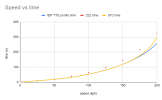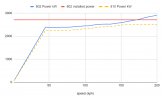Only the 800s have 750hp engines, the 802s and presumably the rest of the Hitachi bi-modes on order have 940hp. It’s better, although not entirely brilliant.
The engines across the whole 800/802 fleet are capable of generating up to 940hp. From what we understand, the actual figure is variable depending mainly on train speed and the position of the power/brake controller. The traction electronics are more complex. HST's used to deliver a fixed engine speed and therefore a fixed power output at a given power controller notch.
On the 800's the power/brake controller simply tells the traction electronics what level of power is required, and the traction system applies as much power as it is programmed to.
Modern car engine ECU's do much the same job, the amount of fuel being injected into your car engine is dependent on throttle position, air flow, and engine speed.
On a modern electric train the traction system similarly has to feed an amount of power to the motors without overloading them and burning them out. Therefore it is programmed to feed in as many amps of electrical power depending on the motors rotational speed.
On a bi-mode, you have to match the engine output to meet the amount of electrical power going to those motors - so two lots of 'mapping' so to speak - to marry the two up so that the system can be responsive but not too responsive so as to risk damaging drivetrain components.
GWR took a decision to have a common 940bhp capable fleet in diesel mode. And GWR has a far greater proportion of diesel running - and needs the higher outputs to ensure journey times on those diesel sections would not be slower than the outgoing HST's.
LNER seem to have stuck with the original 750bhp spec - to keep maintenance costs down. The only significant sections of diesel running are Edinburgh to Aberdeen and Stirling to Inverness via Perth - which are easy schedules at the moment. Clearly the convenience of offering a through service from London to Aberdeen and London to Inverness is worth it even if the schedule north of Edinburgh is slightly slower than the HST GTi's.
You've still got the luggage / van space behind the cab and the first row of seats. Admittedly the 395s do have passenger useable door immediately behind the cab.


